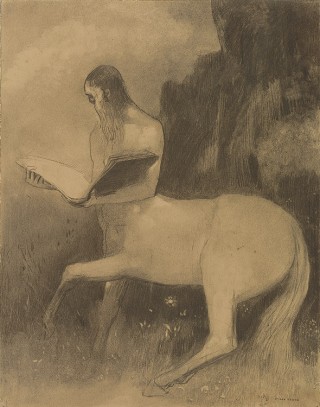Title

Odilon Redon's Centaure lisant (Reading Centaur) is one of many Symbolist illustrations currently on display at the Morgan Library.
(Photo by Thaw Collection, The Morgan Library & Museum, Photography by Steven H. Crossot, 2014.)In the not-too-distant past, many critics condescendingly referred to artists who illustrated books as “mere” illustrators. The Morgan Library effectively puts that tired adjective to rest with its small but elegant exhibition of late 19th- and early 20th-century illustrations, Delirium: The Art of the Symbolist Book (through May 14).
Body
The Symbolist “movement,” if it can be called that (since almost none of the artists involved accepted that appellation), was above all characterized by vagueness and mystery. “Suggérer au lieu de dire” (suggest instead of saying), as the poet Stéphane Mallarmé, one of its leading figures, often said.
This concept poses a dilemma for an artist-illustrator; how does one go about illustrating something that is mysterious, perhaps even incomprehensible? One answer was to attempt to make visual art that was as “musical” as possible, often invoking Wagner’s concept of Gesamtkunstwerk as a principle.
A work by one of the best-known artists in the show, the prolific Odilon Redon (1840-1916), is Centaur Reading, a drawing from the library’s permanent collection. Although not intended for a specific book, it shows how our animal and human instincts, arising from mystery, coalesce. Here we might be tempted to envision Mallarmé’s poem “L’après-midi d’un faune,” which inspired Debussy to compose Prélude à l’après-midi d’un faune. (There’s also a more explicit faune here, by Édouard Manet).
The show, which features work by more than 30 artists, includes a couple of Fernand Khnopff’s more explicit but still elusive illustrations for Symbolist Maurice Maeterlinck’s Pelléas et Mélisande, the play that formed the basis of Debussy’s opera of the same name. Composers and choreographers have often used literature and visual art as inspiration (for example, Mussorgsky’s Pictures at an Exhibition, Respighi’s Trittico Botticelliano, Nijinsky’s Faune, etc.), but when visual artists have done virtually the same thing, they’ve often been criticized for being “too literary.” This exhibit, however, demonstrates that they should be seen as avant-garde, rather than retardataire.




